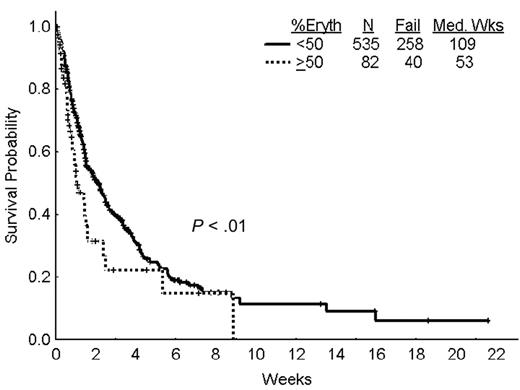Abstract
According to the FAB and WHO classifications, the diagnosis of acute erythroid leukemia is based on the numbers of nucleated red blood cells and myeloid blasts in the bone marrow. The WHO classification recognizes two types of acute erythroid leukemia; M6A with 51–80% erythroid precursors and with 20% or more of the non-erythroid precursors being myeloid blasts; and M6B with more than 80% of the nucleated cells in the bone marrow consisting of erythroid precursors, regardless of the percentage of the myeloid blasts. Previous studies have shown that many cases of acute erythroid leukemia arise in patients with a history of myelodysplastic syndrome and in other cases acute erythroid leukemia is associated with significant dysplastic features. The significance of the number of erythroid precursors is not well known in the myelodysplastic syndromes. In the present study, we included 617 consecutive patients with low-grade myelodysplasia (482 patients with refractory anemia [RA] and 135 patients with refractory anemia with ringed sideroblasts [RARS]). Among this group, 82 patients with 50% or more of erythroid precursors had shorter survival compared with 535 patients with less than 50% erythroid precursors (P < .01; Figure 1). The shorter survival in those with 50% or more of erythroid precursors may reflect the tendency of these patients to have worse International Prognostic Scoring System (IPSS) scores. Thus, among the patients with less than 50% erythroid precursors and primary MDS, 35% were IPSS low, 52% IPSS intermediate 1, and 13% IPSS intermediate 2. For the patients with 50% or more of erythroid precursors, the corresponding proportions were 14%, 57%, and 29%, respectively (P < .001). As a result of the association between IPSS and the percentage of erythroid precursors, the percentage of erythroid precursors had no effect on survival within individual IPSS groups. Similarly, the percentage of erythroid precursors had no prognostic significance in patients with refractory anemia with excess blasts (RAEB) or chronic myelomonocytic leukemia (CMML). Our findings demonstrate that in low-grade dysplasia (RA and RARS) the number of erythroid precursors may represent an important prognostic marker. These findings implicate that the percentage of erythroid precursors should be considered in the classification of the low-grade myelodysplastic syndromes. A multivariate analysis will be performed to ascertain the relative effects of IPSS score and the percentage of erythroid precursors on prognosis in patients with low-grade myelodysplasia.
Author notes
Corresponding author


This feature is available to Subscribers Only
Sign In or Create an Account Close Modal